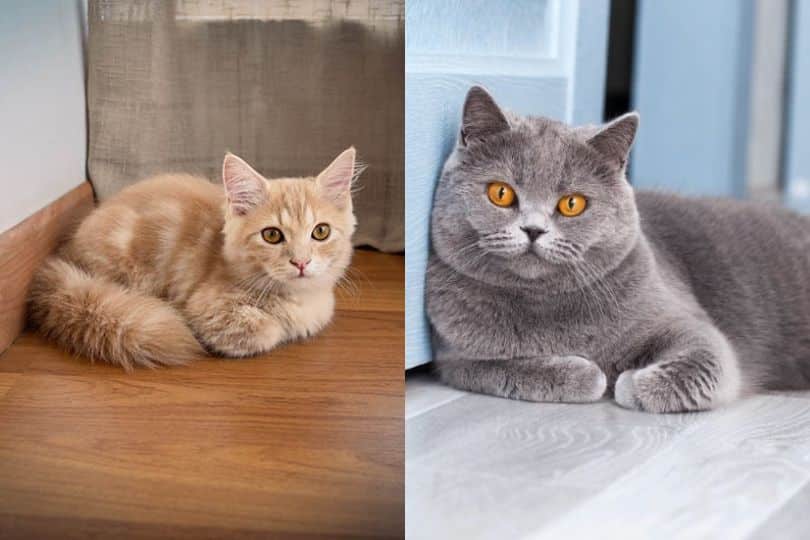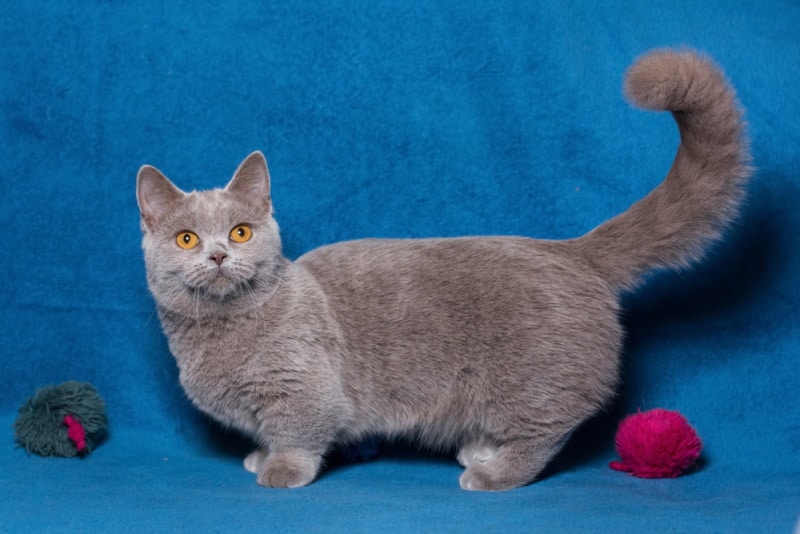Click Below to Skip Ahead
The Munchkin British Shorthair mixed breed creates a feline with short legs with many British Shorthair traits. Generally, these cats almost always have shortened legs, but the exact length can vary. Sometimes, they aren’t remarkably shortened at all.
Breed Overview
Height
5–10 inches
Weight
6–17 pounds
Lifespan
12–20 years
Colors
Varies widely
Suitable for
Cat-lovers who aren’t set on a purebred cat, apartment living
Temperament
Affectionate and easy-going
Because this is a mixed breed, it’s hard to determine precisely what you’ll end up with. The kitten can inherit traits from either parent, allowing them to have various personalities and appearances. Therefore, this mixed breed is most suited for those that don’t mind a bit of a surprise. If you’re looking for very particular traits, we don’t recommend adopting a mixed breed.
However, for those looking for an interesting breed, this option may be suitable for you.
Munchkin British Shorthair Characteristics
Munchkin British Shorthair Kittens

Munchkin British Shorthair mixes aren’t super common, but it may not be completely impossible to find one. That’s because Munchkin cats must be bred with cats of another breed, since due to the gene mutation that causes their short legs, breeding two Munchkin cats together can cause many kittens to be stillborn.
However, if you’re looking for a Munchkin British Shorthair mix specifically, know that you may have to travel to find a breeder, as neither of these cats are super common. Just make sure that you do your research carefully to find a reputable breeder. A good breeder should be knowledgeable of the breeds and be able to provide health clearances, as well as answer any questions you may have without hesitation.
Temperament and Intelligence of the Munchkin British Shorthair
These felines have varying personalities but they all tend to be very affectionate and outgoing. These cats were bred to be companion animals and so they get along well with people and other cats. Most of these felines are well-suited for living in our modern homes. However, because there is some variance, you can never be sure what you will get.
Some of these felines will be more affectionate than others. Others may require more attention. Some may be extremely playful and energetic. While there is a genetic difference in temperament, there is also an environmental difference. How the cat is socialized and raised will affect the feline’s temperament and sociability.
We highly recommend socializing them early. This ensures they are well-socialized and less likely to fear new situations.
Are These Cats Good for Families? 👪
These cats can be a great option for families. However, again, it depends on the cat. As a mixed breed, there is such a large variance in personality that it can be difficult to determine how the cat will end up. Therefore, we recommend socializing these cats well to ensure they are as friendly and accepting as possible.
Taking these cats around other animals and people at an early age is essential. Be sure to get them around children and others at an early age. Children often act differently from adults, and it is easy for cats to be scared of them if they’ve never been around them before. Fear often leads to the cat running away and hiding. However, it can also lead to scratching and biting if the cat feels cornered.
Things to Know When Owning a Munchkin British Shorthair
Food & Diet Requirements 🐡
These cats do not have any special dietary requirements. They require the same food that other felines require in about the same amounts. These cats may be a bit lazier than others, however. In this case, they may require less food or even a diet food to remain at a healthy weight. Because many cats in America are obese, it is vital that you don’t let your cat join this statistic. It can lead to plenty of negative health effects, just like it does in humans.
In terms of choosing the right cat food, there are a few things to keep in mind. Cats are obligate carnivores. This means that they must have meat in their diet to survive. Typically, more meat is better. Check for named meats that are either whole or meals.
Meat meals are generally more nutritious than whole meat. Therefore, they are a great option for most felines.
Exercise 🐈
These felines may have short legs, but they aren’t usually held back by this. They may be unable to jump as high as other cats due to their shorter stature. However, they can still get around well.
With that said, these cats may be a bit lazier than most. For this reason, we recommend that owners consider ways to encourage exercise. Otherwise, these cats may become obese, putting even more strain on their back.
Climbing structures, playtime, and interactive toys are all useful options. Having many different toys can encourage play since it helps prevent your feline from getting bored. We recommend that owners play with their felines daily. Not only does this help them exercise, but it also helps build a trusting relationship.
When you aren’t home, interactive toys are a great option. These can help get your cat moving without them needing to add any input to the toy at first. While many interactive toys require treats, we recommend utilizing your cat’s normal kibble.
Training 🧶
This mixed breed isn’t known as the most trainable cat out there. It isn’t that they aren’t intelligent. Instead, they don’t have the same level of devotion and trainability that dogs have. Their attention span is shorter, and they are far less food-driven. This makes training these cats more difficult than dogs (or other cat breeds).
However, it isn’t impossible. It’s smart to train your cat in several important things to help make both of your lives a bit easier. For instance, we recommend crate-training your cat to make transport easier. Training your feline to help you handle their paws and stomach is also important for health reasons.
Crate-training a cat is pretty straightforward. You want the crate to be seen as a happy place. We recommend leaving the crate out and placing blankets inside. You can add treats, a puzzle toy, and catnip to get your cat interested and interacting with the crate. Then, when you need to transport your cat, the crate won’t be new or scary.
Grooming ✂️
These cats won’t require much grooming. No matter what parent they take after, these felines will have shorter hair that isn’t prone to matting. Therefore, you won’t have to worry much about grooming. Many of these cats take well enough care of their coat that you won’t need to do much.
However, if you want to minimize shedding, brushing them weekly is a good idea. A simple pin brush works well. Start early, so your feline is used to the process when they are older. Your cat won’t need to sit for very long—about 5 minutes is enough.
You will need to trim your cat’s nails sometimes. If you have many scratching posts and climbing areas, your cat may not need them trimmed. However, some cats won’t scratch enough to keep them worn down.
Health and Conditions 🏥
These cats are quite healthy as they are a mixed breed, which means they are less likely to inherit genetic conditions from either of their parents. However, this doesn’t mean that they are foolproof. If they have shorter legs, they may develop some conditions associated with their short legs and unusual bone growth.
For instance, shorter legs can lead to lordosis, which is caused by a curving spine. Kittens are particularly prone to this issue as they are growing. Pectus excavatum can also occur in kittens. This condition appears when a cat’s ribs and sternum do not grow properly, causing its chest to be “open.” Usually, surgery is required to keep the kitten healthy.
Osteoarthritis can also occur, especially in the leg joints. Sometimes, it can be so serious that one of the limbs becomes lame. While this condition usually appears in older cats, it can affect younger cats, as well.
- Osteoarthritis
- Hyperthyroidism
- Pectus excavatum
- FLUTD
- Lordosis
- Uremia
- Pancreatitis
Male vs Female
There is no difference between the sexes in this breed—besides the usual differences found across all cats. Males are more likely to mark for instance, and may be more likely to roam. Females can go into heat and get pregnant and may be slightly smaller than males.
However, there are no breed-specific differences.
3 Little-Known Facts About Munchkin British Shorthair Kittens
1. They vary a lot.
These kittens are rarely the same. Because they are a mixed breed, they have a relatively wide genetic pool. Therefore, kittens are more likely to end up with varying traits. For this reason, this “breed” is much less set in stone than others. You don’t know what you’ll get, and kittens can change a lot while growing.
Therefore, you won’t know what kind of cat you’ll get until they are an adult!
2. Not all of them have short legs.
Not all of these cats have short legs—if you’re set on a cat with stubby legs, this may not be the best option for you. (However, not even all Munchkin cats have short legs.)
3. Some medical issues are associated with their short legs.
While their short legs are cute, these felines are prone to health issues due to their short legs, and they tend to live shorter lifespans than other cats.
Mixed breeds tend to be healthier than other felines. However, if they have short legs, they will likely inherit all the issues that tend to come with it. Therefore, this mixed breed won’t necessarily be healthier.
Final Thoughts
The Munchkin British shorthair mix often leads to a short-legged feline with some of the characteristics of a British shorthair. Typically, these felines are healthier than the typical Munchkin breed. However, it does depend on the cat’s legs and exact genetics. Munchkin cats are prone to several health issues due to their unusual bone growth, and their kittens can inherit these.
These felines can make good family pets. However, they aren’t necessarily as outgoing as other cats. Therefore, it’s vital to socialize them early and often.
Featured Image Credit: Sviatoslav_Shevchenko, Shutterstock












